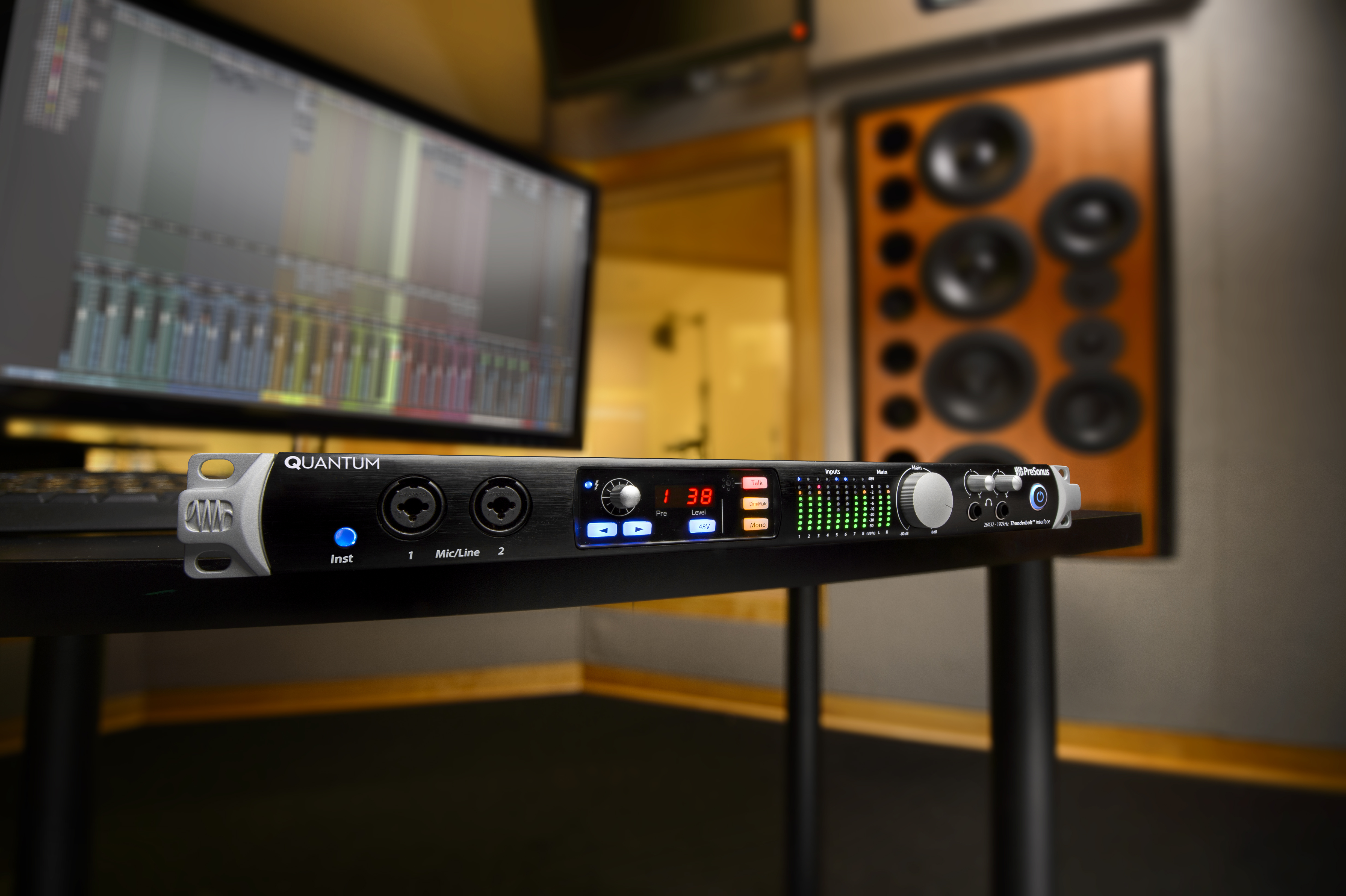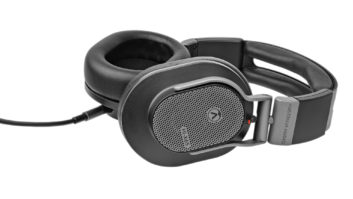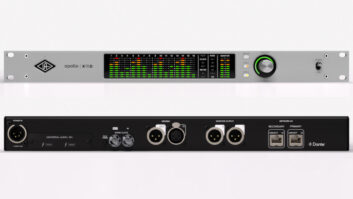PreSonus has rolled out a whole control room of gear in recent years, from mic preamps to monitors, with mixers, interfaces and control surfaces in between. While all of the company’s digital products acknowledge the importance of integration and provide DAW-agnostic compatibility, they go above and beyond when interacting with the PreSonus-branded DAW, Studio One.
Quantum, PreSonus’ new flagship recording interface, is no exception. PreSonus Quantum is a 26 x 32 Thunderbolt audio interface and studio command center, while Quantum 2 is a 22 x 24 Thunderbolt audio interface. Through driver design and the use of Thunderbolt connectivity, class-leading round-trips through a DAW can potentially be achieved. Does it deliver in practice like it does on paper?

On the Surface
Across the back panel of the Quantum you’ll find the majority of the input and output connectors. The unit has two Thunderbolt 2 connectors, which is especially convenient when considering that up to four Quantum units can be daisy-chained and recognized by one system. Two pairs of ADAT Optical input and output connectors allow for 16 channels of digital I/O at 48 kHz (ADAT), or eight channels at 96 kHz (SMUX). S/PDIF I/O is provided through a pair of RCA connectors. A pair of balanced 1/4-inch TRS connections, which serves as the main analog monitoring option, accompanies a set of eight auxiliary 1/4-inch balanced output connectors.
Six XLR/TRS combo jacks across the back panel can feed either the A/D at line level or the digitally controlled XMAX mic preamps when using the XLR component. On the front panel, two more combo jacks can be used for either mic, line or instrument-level signals.

The front panel also features a large volume control knob that can be assigned to control any combination of output pairs in addition to the main output pair. Softkeys are provided for useful monitoring functions like mono-summing, dimming and muting. An integrated talkback mic, which can be routed through a DAW to the various outputs, can be activated with another softkey, which automatically dims the control room output. Two headphone jacks, each with their own master volume control, can be fed separate mixes, built through the DAW.
A concise onboard control panel—called Universal Control—allows input selection and gain control, with an endless rotary encoder making the adjustment, and provides software meters. The XMAX preamps also can be controlled from the unit’s front panel.
Unlike the software control panels accompanying nearly every interface today, there is no integrated software mixer in Universal Control. These software mixers usually allow direct input monitoring, or at least ultra-low-latency input monitoring when hardware buffering in the host DAW causes audible round-trip monitoring delays. When cutting basic tracks with a low buffer setting, relying on the speed of the Thunderbolt bus, latency shouldn’t be an issue. When overdubbing on a session where plug-ins and automation force a higher buffer setting, this could be problematic. More on this later.
While any DAW can be made to control the Quantum’s mic preamps via MIDI, the “above and beyond” Studio One integration comes in the form of preconfigured preamp controls within their DAW. This idea of keeping everything—plug-in settings, monitoring faders, headphone mixes and input gain—all on the same screen removes the distraction of your eyes leaving the DAW to look at the interface. The added bonus is that gain values saved within a Studio One session can be reapplied to the hardware upon reopening that session.

Putting Quantum to the Test
In order to get the truest Quantum experience, I worked with Studio One. With most music projects that I do, the artists want to take the session home and overdub parts on their own between tracking and mixing. One lingering problem is that there is no practical way to export and import project data between Studio One and other DAWs, though the company assured me that the feature is “on the roadmap.”
For this review, I wrote and recorded a set of songs specifically for the purpose of exploring Quantum and Studio One. Phase one would be to write and record demos on my own while learning the system. Because I hadn’t upgraded Studio One since version 2.6, I was learning Studio One 3.5 as well as the operation of the Quantum. For phase two, I would team up with some talented musicians for full band tracking sessions.
When creating a new session, tracking templates are available for all current PreSonus hardware; selecting one populates a corresponding I/O setting. Unfortunately, this process was not as simple when opening existing sessions. Annoyingly, Studio One cannot import or export I/O settings. Instead, a single default setting can be learned and applied to other sessions. With that, I was able to make a new session with a template, “steal” its I/O settings and apply them to existing sessions.
While in the Audio Setup preference pane, I discovered a feature, new to Studio One version 3.5, which answered one big question I had about Quantum. The Dropout Protection feature of Studio One allows plug-in-heavy, CPU-draining sessions to maintain a low-latency monitoring option, despite large hardware buffer settings. As I understand it, this is accomplished by backing off CPU usage in different ways. Native Low Latency Monitoring allows recording while monitoring through active plug-ins on the same track, provided that each plug-in can process in under 3 milliseconds. Using this technology, I was able to scratch out guitars for demo songs using software-based amp modeling software.
Multichannel Preamps with I/O, by Strother Bullins, Jan. 31, 2018
This gave me an opportunity to use Quantum’s front-panel instrument inputs, which performed nicely. There was plenty of headroom, which I appreciated when working with a guitar that had really hot pickups. The overall character was darker than other interface instrument inputs I’ve heard, and it didn’t pronounce some of the subtleties that I heard when A/B’ing against an external transformer-based DI. That said, the sound played nicely into virtual fuzz pedals and amp distortion.
To accommodate for the basic tracking lineup of drums, two guitars and scratch vocal, I expanded Quantum’s I/O using an external mic preamp with ADAT output. Because the Quantum was the star, I wanted to rely on its clocking, which features a dedicated BNC wordclock output that I could feed to the preamp. While the interface itself had no metering for the ADAT inputs, I could confirm signal in the Universal Control software.
When level-checking, I was pleased with the sound of the mic preamps when paired with drum mics. The transient response was right on. I noticed the sound was a little dark, but it was also full in the bottom end without being muddy. The preamps catered well to a miked guitar amp, with a heavily distorted sound. The overall character was thick and meaty without being harsh in the top end.
As I started building headphone mixes, it wasn’t long before I realized I might not have been ready to take my Studio One skills out on open water yet. While I was able to build a latency-free headphone mix for myself, everyone else’s headphones were laggy. I realize now that that was user error.
Another problem that came up was inexplicable. At some point, despite signal showing as present on the hardware, in the Universal Control software, and even in the metering of the audio I/O settings of Studio One, certain input channels stopped feeding tracks in the DAW. After power cycling, restarting and trying every other troubleshooting method I could think of, we decided to test the interface with Pro Tools to suss things out.
After selecting Quantum as the playback engine in Pro Tools and configuring a low hardware buffer setting, I jumped into the Pro Tools I/O interface. I was pleased to see that when configuring the default settings, all of Quantum’s inputs and outputs were labeled correctly and specifically. Unlike other interfaces, which have used really generic names like “Audio 1-2,” the Quantum inputs were precisely identified as “Instrument/Mic/Line Input 1,” “Talkback” or “Headphones 1,” for example. Thanks to this consideration, the session was built and headphone mixes were routed in a snap. On top of that, all of the inputs were now correctly feeding the designated tracks. Everyone was happy, so we decided to do the session in Pro Tools.
Want more stories like this? Subscribe to our newsletter and get it delivered right to your inbox.
Tracking onto blank tracks with no plug-ins, in a 44.1 kHz session, the system could easily perform at high track counts, with buffer settings at a impressively low 64 samples. Even after mixing, with the addition of plug-ins and automation requiring further increases in buffer settings to avoid CPU overloads, overdubbing was still possible.
With a hardware buffer setting of 256 samples or less, I was able to insert guitar effects onto a track and monitor through them without noticeable latency. When overdubbing late in the mixing phase, on sessions requiring buffer settings of 512 to 1024 samples, the latency was, not surprisingly, a deal-breaker. At this point, taking advantage of the new “freeze” function in Pro Tools became the only solution for freeing up enough CPU to lower the buffers for the sake of round-trip speed but still avoid CPU overloads.

The Bottom Line
From the start, I had my doubts about tracking with an interface that has no front-end software mixer. That said, Quantum proved to be a fast interface. Overall, it even seemed faster than other Thunderbolt interfaces that I’ve tried, allowing higher buffer settings than usual. If you want to use it with Pro Tools, however, make sure that you’re running Pro Tools 12 or higher so you can freeze tracks when the CPU load starts to climb.
Product Summary
Company: PreSonus
Product: Quantum Thunderbolt Interface
Website: www.presonus.com
Price: $999.95 (street price)
Pros: Extremely fast bus speeds. Flexible control of preamps from Studio One or iPad.
Cons: No integrated software mixer.







